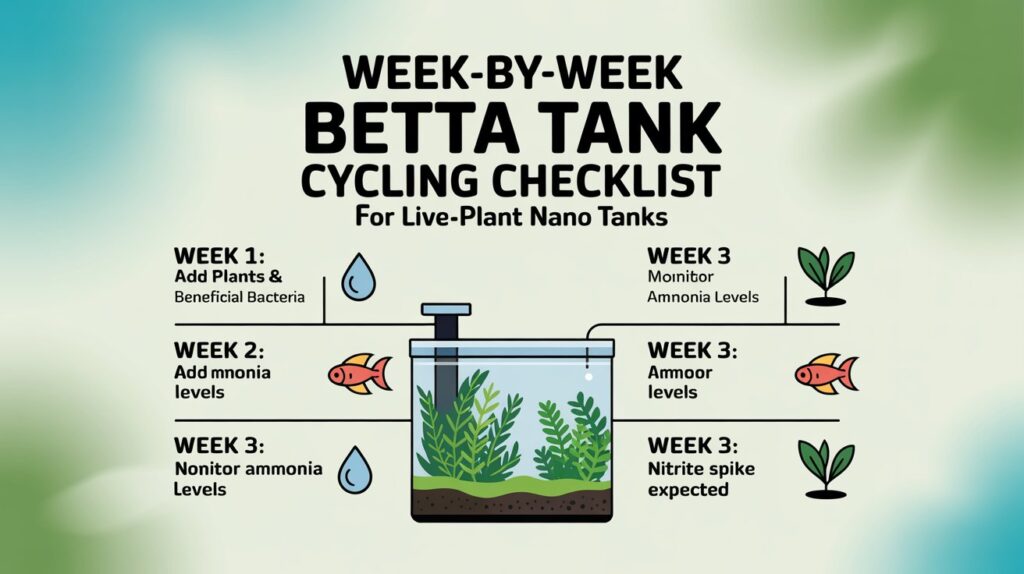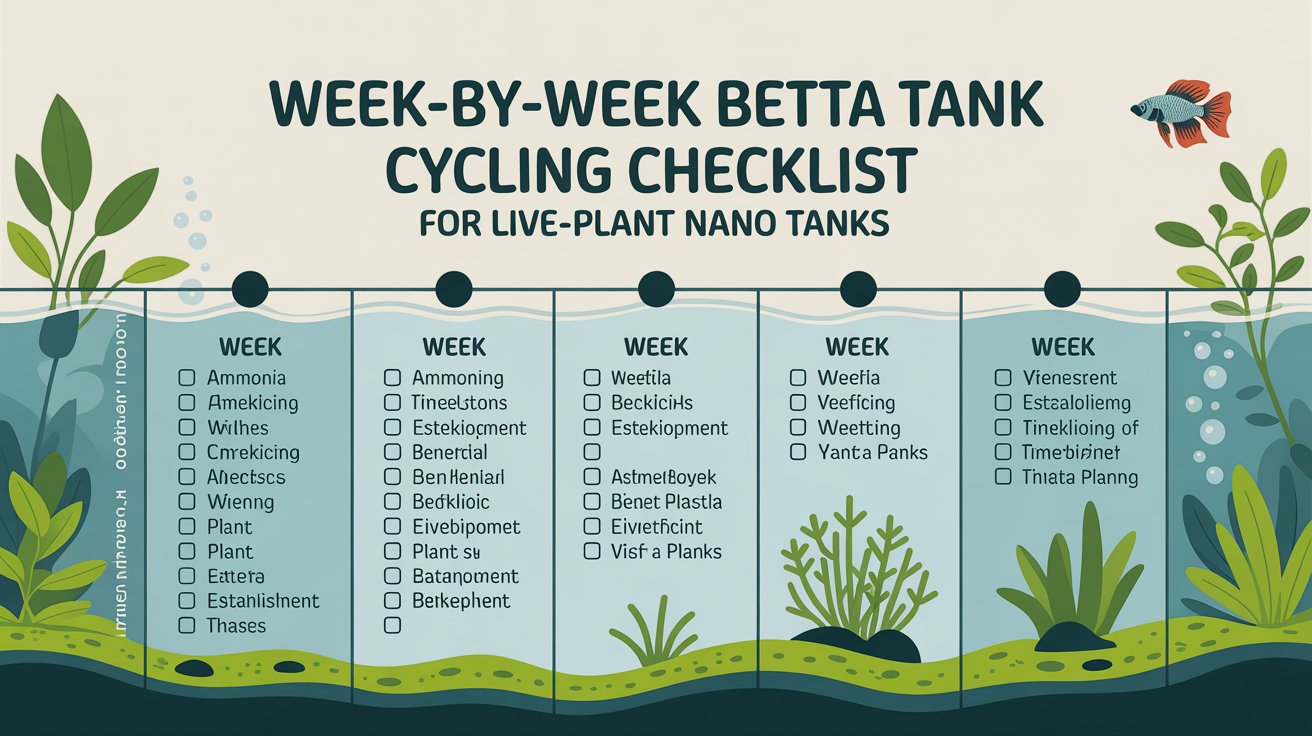Why Cycling Matters for Bettas & Planted Nano Tanks
Before adding your colorful betta to a nano aquarium, the tank must go through a process called cycling. Cycling builds beneficial bacteria in your filter and substrate that convert toxic ammonia → nitrite → nitrate, ensuring a safe and stable habitat.
For small nano tanks (3–10 gallons) with live plants, this process is delicate. Plants help stabilize the ecosystem, but improper cycling can harm both flora and fauna. This guide breaks the process down week by week, showing exactly what to test, observe, and adjust.
Overview: What You’ll Need Before Starting
Equipment Checklist:
- 5–10 gallon aquarium
- Sponge or internal filter (gentle flow preferred for bettas)
- Dechlorinator (Seachem Prime or equivalent)
- Liquid water test kit (API Master Test Kit recommended)
- Live plants (Java moss, Anubias, Java fern, stem plants, etc.)
- Aquarium-safe substrate
- Heater (set at 78–80°F)
- Optional: bottled bacteria starter (e.g., Tetra SafeStart)
Week 0: Setup & Initial Planting
This is the “foundation week.” Your goal is to create a stable planted environment before adding ammonia or fish.
Steps:
- Rinse substrate and decor.
- Add substrate and fill the tank halfway with dechlorinated water.
- Plant your chosen live plants — Java moss, Anubias, and Cryptocoryne thrive in low-light, low-tech tanks.
- Add the filter and heater, fill the rest of the tank, and let it reach 78–80°F.
- Keep the light on 6–8 hours/day.
Tip: Add a bacterial starter if you have one to jumpstart the cycle.

Week 1: Introducing Ammonia & Monitoring
Now, you’ll introduce an ammonia source (fishless cycling) to feed the bacteria that will soon colonize your filter.
Steps:
- Dose pure household ammonia (2–3 ppm).
- Test ammonia daily.
- Plants may begin showing small new growth — a good sign of stability.
Goal: Maintain ammonia around 2–3 ppm. No nitrites or nitrates yet — that’s normal.
Suggested Image:
“Close-up of a test kit with blue ammonia reading — captioned ‘Week 1: Ammonia feed stage.’”
Week 2: Nitrite Spike Begins
Beneficial bacteria begin converting ammonia into nitrite. This is a turning point in your cycling process.
Steps:
- Test every 2–3 days.
- Ammonia should start dropping; nitrite will rise (1–2 ppm).
- Continue adding ammonia daily to maintain 2 ppm.
- Trim any melting plant leaves to prevent rot.
Signs of progress: Slight cloudiness in water and rising nitrite levels. Don’t panic — it’s part of the bacterial bloom.

Week 3: Nitrates Appear — Nearly There
You’ll start seeing the final product of the nitrogen cycle: nitrates.
Steps:
- Test ammonia, nitrite, and nitrate every 2–3 days.
- Expect readings:
- Ammonia: 0.5–1 ppm
- Nitrite: 1–2 ppm
- Nitrate: 10–20 ppm
- Add a few floating plants like Salvinia or Amazon frogbit — they help absorb excess nitrates.
Goal: Get ammonia and nitrite close to zero.

Week 4: Stability Check & Mini Water Change
At this stage, beneficial bacteria colonies are growing strong.
Steps:
- Test parameters:
- Ammonia: 0 ppm
- Nitrite: 0 ppm
- Nitrate: 10–30 ppm
- Perform a 25–30% water change to reduce nitrate buildup.
- Keep the filter running continuously (don’t clean the media yet).
- Ensure plants are pearling (releasing oxygen bubbles) — a sign of balance.
Suggested Image:
“Photo: Healthy planted nano tank with pearling plants and clear water — caption ‘End of Week 4: Stable ecosystem.’”
Week 5: Introducing Your Betta
If all tests show ammonia = 0, nitrite = 0, and nitrate < 30 ppm, your tank is ready for its first resident.
Steps:
- Float the betta in its bag for 15–20 minutes to acclimate to temperature.
- Gradually add tank water into the bag every 5 minutes (for ~20–30 minutes total).
- Gently release your betta into the tank.
- Feed lightly (betta pellets, frozen daphnia). Overfeeding may restart ammonia spikes.
Suggested Image:
“Photo: Betta fish being acclimated in a bag inside a planted tank — step-by-step arrows showing process.”
Week 6: Observation & Final Adjustments
Your tank is now biologically cycled, but close monitoring continues for at least one more week.
Checklist:
- Daily visual inspection of betta behavior (active, flaring, exploring).
- Weekly tests for ammonia/nitrite/nitrate.
- Trim dead leaves, vacuum lightly if needed.
- Add shrimp or snails only after 1–2 weeks of stable readings.
Suggested Image:
“Macro shot: Betta swimming among Java moss and shrimp — caption ‘Balanced nano community.’”
Weekly Testing & Maintenance Summary Chart
| Week | Ammonia | Nitrite | Nitrate | Water Change | Notes |
|---|---|---|---|---|---|
| 0 | 0 | 0 | 0 | None | Setup, plant, stabilize |
| 1 | 2–3 ppm | 0 | 0 | None | Add ammonia |
| 2 | ↓ | ↑ | 0 | None | Nitrite spike |
| 3 | 0–0.5 | 1–2 ppm | 10–20 ppm | Optional | Nitrate begins |
| 4 | 0 | 0 | 10–30 ppm | 25–30% | Stable biofilter |
| 5 | 0 | 0 | <30 ppm | 25% | Add betta |
| 6 | 0 | 0 | 10–20 ppm | 25% weekly | Ongoing care |
Common Mistakes to Avoid
- Overcleaning the filter during cycling — kills bacteria.
- Adding fish too early.
- Skipping water testing.
- Overdosing ammonia beyond 4 ppm.
- Using chlorinated tap water without conditioner.
Pro Tips for Low-Tech Planted Nano Tanks
- Add floating plants for extra stability.
- Use a gentle sponge filter to avoid fin damage.
- Avoid bright, long lighting hours — algae may bloom.
- Keep consistent feeding — overfeeding causes ammonia spikes.
- Use Indian almond leaves (Catappa) to release tannins and support fish health.
FAQs
Q1: Can I cycle a betta tank with the fish inside?
A1: It’s possible, but not recommended. Fish-in cycling can stress or kill your betta due to ammonia exposure. Fishless cycling is safer and faster.
Q2: How long should the cycling process take?
A2: Generally 4–6 weeks for a small planted tank, though using bacteria starters can shorten it to 2–3 weeks.
Q3: My nitrite level is stuck for two weeks. What should I do?
A3: Stop adding ammonia for a few days, perform a partial water change, and ensure oxygenation — this helps nitrite-eating bacteria thrive.
Q4: Do live plants replace the need for cycling?
A4: No. Plants help absorb some ammonia and nitrates, but beneficial bacteria are still required for long-term balance.
Q5: When can I add shrimp or snails?
A5: Wait 1–2 weeks after adding the betta to confirm stable readings. Shrimp are sensitive to any ammonia traces.
Conclusion
A properly cycled betta nano tank means crystal-clear water, lush plant growth, and a stress-free fish. By following this week-by-week checklist, you build a thriving mini-ecosystem that maintains itself with minimal intervention. Patience during these first six weeks pays off in long-term stability and beauty.
Cycling isn’t just a process—it’s the foundation of a living, breathing underwater world for your betta.

